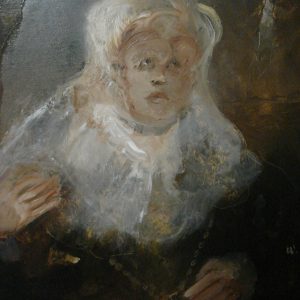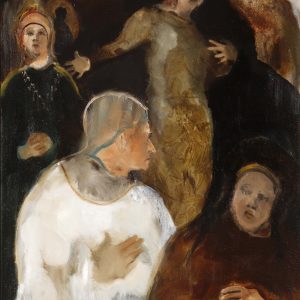Description
Artist/Maker: Yannis Papayannis (b. 1962)
Object/Materials and Techniques: Oil, gold and silver on canvas
Date: Painted in 2014
Dimensions: H. 55 cm. x W. 40 cm.
Art style: Abstract art/Expressive elements with expressionistic structures/Gesturalism
Current Location: Artist’s collection
Curator’s note: Three paintings from Yannis Papayannis that belong to the series The Queen of the Night inspired by the famous ancient Mesopotamian terracotta plaque in high relief, known as the Burney Relief or the Queen of the Night Relief.
The antiquity is displayed in the British Museum in London and dates between 1800 and 1750 BCE, the Isin-Larsa period (c. 2025 – c. 1763 BCE) which constitutes the first part of the Old-Babylonian period (2025 – 1595 BCE). It is considered as a staggeringly rare survival from the period, distinguished for its particular iconography and relatively large size which profound its use as a cult relief.
Yannis Papayannis, herein, illustrates a winged, nude, goddess-like figure with talons, surrounded by owls and standing upon two lions, as depicted on the antique panel.
The chosen colour palette of the background reflects the seven characteristic colours of the Sumerian Temples of ancient Mesopotamia: silver, blue, yellow, gold, red, orange and black, a chromatic motif that Yannis Papayannis has repeatedly used in other series of works as well.
Through his very personal artistic language that consists of energetic intense brushstrokes and explosive gesturalism he redevelops and reforms in a new complex, with special vibe and colour, the image of the ancient goddess. He chooses to render his subject in an overall lush and immersive imagery characterized by extravagance and lavishness as an ode to the depicted universal deity.
He creates an adorable female-shaped figure that gives off femininity and sensuality in a like manner to the original deity model. Moreover, highlighting her by flashes of reflected light plus bright colours, or gleaming her in a mirror, he seeks to output the intensity of her cosmic energy through a highly seductive way.
Thus, Yannis Papayannis brings to this interpretation his signature sense of the so-called ‘action painting’. Through eloquent elements with expressionistic structures he manages not only to introduce the ancient goddess to the spectators but also to trigger their senses, arousing their curiosity about her identity.
Who is she?
She, indeed, like every great beauty, has a mystery attached and till today the relief goddess constitutes a matter of debate whether she represents the female demon Lilītu (Lilith), the multifarious goddess Inanna / Ishtar, or the goddess / ruler of the Underworld Ereshkigal.
On this wise, capitalizing on ancient goddess’ primal and emblematic status, Yannis Papayannis creates an impressive vision of a timeless symbol and makes her shine brightly like a real Star, worthy of her title ‘Queen of the Night’.
Notation:
- British Museum’s newest treasure, the Burney Relief / Queen of the Night Relief which measures 19 inches by 14 inches, is the most important Near East antiquity. The Museum’s experts were ‘thrilled’ about the acquisition that took place in 2003.
- In short description, the winged nude female figure, as depicted on the Mesopotamian antiquity, shown full frontal, wears a horned head-dress (identical to one in the Louvre stele), an elaborate necklace and bracelets on each wrist. She holds the rod and ring of justice in each hand while her talon feet are resting on lions. The figure is flanked by a pair of standing owls which suggest that she is connected with the underworld. Black, white, red and yellow pigment traces witness that once she would have probably been highlighted and highly decorated.
- Lilith may be linked in part to a historically earlier class of female demons (lilītu) in ancient Mesopotamian religion, found in cuneiform texts of Sumer, the Akkadian Empire, Assyria, and Babylonia.
- Inanna is an ancient Mesopotamian goddess associated with love, beauty, sex, desire, fertility, like the universal ancient Hellenic goddess Aphrodite, but also with war, justice, and political power. She was originally worshipped in Sumer and was later worshipped by the Akkadians, Babylonians, and Assyrians under the name Ishtar.
- Ereshkigal (literally ‘great lady under earth’) in Mesopotamian mythology was the goddess of Irkalla, the land of the dead or Underworld and older sister of Inanna / Ishtar. Sometimes her name is given as Irkalla, similar to the way the name Hades was used in ancient Hellenic mythology for both the Underworld and its ruler.
Bibliographic References:
- Dominique Collon, The Queen of the Night. British Museum Objects in Focus, London, British Museum Press, 2005.
- Tallay Ornan,The Triumph of the Symbol: Pictorial Representation of Deities in Mesopotamia and the Biblical Image Ban (Orbis Biblicus et Orientalis 213), Fribourg: Academic Press / Göttingen: Vandenhoeck & Ruprecht, 2005.

![Yannis Papayannis – Untitled (3/3) [From the series The Queen of the Night] Yannis Papayannis – Untitled (3/3) [From the series The Queen of the Night]](https://storage.googleapis.com/n-art.org/2019/04/PAPAGIANNIS-2.7-scaled.jpg)



